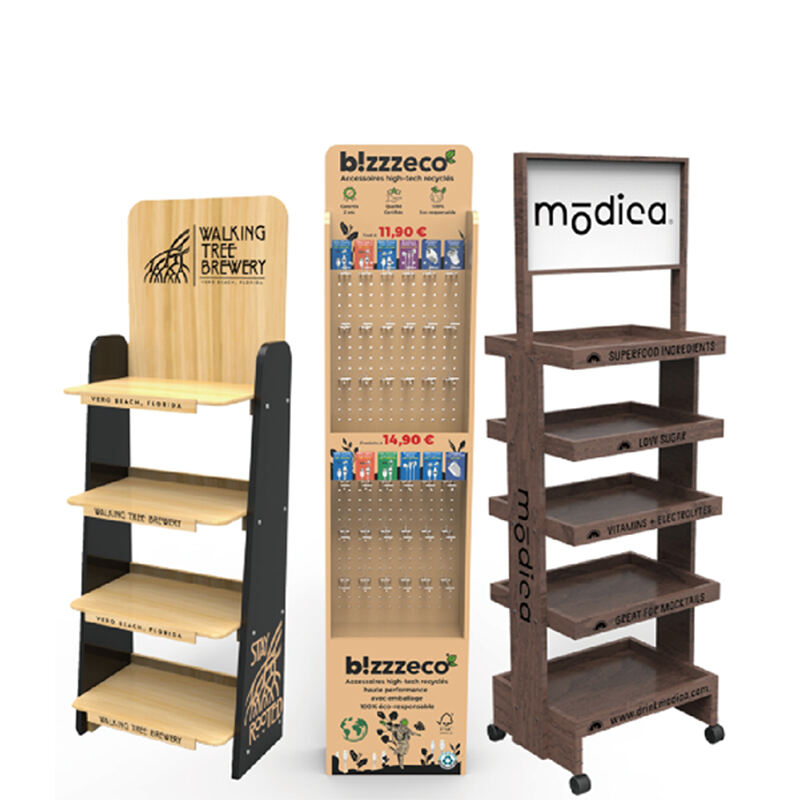Selecting the right display stand for your products is a critical decision that can significantly impact your sales performance and brand presentation. Whether you operate a retail store, participate in trade shows, or showcase products in corporate environments, the effectiveness of your display solutions directly correlates with customer engagement and purchasing decisions. A well-chosen display stand not only highlights your products but also communicates your brand values and professionalism to potential customers.

The modern retail landscape demands sophisticated presentation solutions that capture attention in increasingly competitive environments. Today's consumers are drawn to visually appealing displays that make products easily accessible while creating memorable shopping experiences. Understanding the fundamental principles of effective product presentation will enable you to make informed decisions about display investments that generate measurable returns.
Understanding Display Stand Materials and Construction
Wood Display Solutions
Wooden display stands offer unparalleled versatility and aesthetic appeal for various retail environments. Pine wood, in particular, provides an excellent balance of durability and cost-effectiveness while maintaining the natural warmth that appeals to many consumers. The grain patterns and natural textures of wood create an organic feel that enhances product presentation, especially for brands emphasizing sustainability or craftsmanship.
When considering wooden display options, evaluate the finishing quality and construction methods used in manufacturing. High-quality wood displays feature precise joinery, smooth sanding, and protective finishes that resist wear and maintain appearance over extended use. The natural properties of wood also allow for easy customization through staining, painting, or branding applications that align with your specific marketing requirements.
Metal and Composite Alternatives
Metal display stands provide exceptional durability and modern aesthetic appeal for contemporary retail spaces. Steel and aluminum constructions offer superior weight-bearing capacity while maintaining sleek profiles that complement minimalist design approaches. These materials resist damage from frequent handling and transportation, making them ideal for businesses requiring portable display solutions.
Composite materials combine the benefits of multiple substrates to create display stands with specific performance characteristics. These engineered solutions often incorporate metal frameworks with decorative panels or specialized coatings that provide unique visual effects. Understanding material properties helps retailers select displays that withstand their specific operational demands while maintaining professional appearance standards.
Analyzing Your Product Requirements
Size and Weight Considerations
Product dimensions and weight directly influence display stand selection criteria. Heavy items require robust construction with adequate base stability to prevent tipping or structural failure. Conversely, lightweight products may benefit from displays that emphasize visual impact over structural reinforcement, allowing for more creative design approaches.
Calculate the total load capacity needed by considering not only individual product weights but also the cumulative effect of fully stocked displays. Include safety margins in your calculations to account for dynamic loading conditions such as customer interaction or transportation vibrations. Proper load analysis ensures long-term display performance and prevents costly failures or safety incidents.
Product Categories and Display Logic
Different product categories benefit from specific display approaches that enhance their appeal and accessibility. Fashion items require displays that allow easy browsing and size comparison, while electronics need secure mounting with clear visibility of features and specifications. Food products demand hygiene-conscious designs with easy cleaning capabilities and appropriate material selection.
Consider the customer journey and interaction patterns associated with your product category. Impulse purchases benefit from eye-level placement and easy access, while considered purchases may require more detailed information presentation and comfortable viewing angles. Matching display characteristics to customer behavior patterns maximizes the effectiveness of your presentation strategy.
Evaluating Space and Environment Factors
Floor Space Optimization
Efficient space utilization requires careful consideration of display stand footprints relative to available floor area. Compact designs maximize product density while maintaining adequate customer circulation space. Vertical display strategies often provide superior space efficiency compared to horizontal arrangements, particularly in high-rent retail locations where floor space costs are significant.
Multi-level display configurations create visual interest while accommodating diverse product ranges within constrained spaces. Tiered arrangements allow for logical product grouping and price point segregation that guides customer decision-making processes. Consider modular systems that enable flexible reconfiguration as inventory or seasonal requirements change.
Lighting and Visibility Requirements
Ambient lighting conditions significantly affect display stand effectiveness and should influence material and color selection decisions. Reflective surfaces can enhance product visibility in well-lit environments but may create glare issues under direct lighting. Matte finishes provide consistent appearance across varying lighting conditions while minimizing maintenance requirements.
Integrated lighting solutions within display stands create dramatic product presentation opportunities while ensuring consistent visibility regardless of ambient conditions. LED strip lighting offers energy-efficient illumination with minimal heat generation, protecting sensitive products while highlighting key features. Consider the electrical infrastructure requirements and safety certifications needed for illuminated display solutions.
Brand Integration and Customization Options
Corporate Identity Alignment
Effective display stands reinforce brand identity through consistent color schemes, typography, and design elements that create cohesive customer experiences. Custom graphics applications, logo integration, and branded messaging transform functional displays into powerful marketing tools that communicate brand values and positioning strategies.
Color psychology plays a crucial role in display effectiveness, with specific hues triggering emotional responses that influence purchasing behavior. Warm colors create welcoming atmospheres suitable for lifestyle products, while cool colors convey professionalism appropriate for technical or business-oriented merchandise. Ensure color selections complement both your brand palette and the products being displayed.
Customization Feasibility and Costs
Custom display solutions offer unlimited design possibilities but require careful cost-benefit analysis to ensure reasonable return on investment. Standard modifications such as color changes or simple graphics applications typically add minimal cost while providing significant brand differentiation. Complex structural modifications or unique materials may substantially increase costs and lead times.
Evaluate the scalability of customization decisions across multiple locations or product lines. Standardized custom elements can reduce per-unit costs while maintaining brand consistency across diverse retail environments. Consider the long-term implications of custom choices on maintenance, replacement, and expansion requirements.
Budget Planning and Return on Investment
Initial Investment Analysis
Display stand investments should be evaluated within the context of overall marketing and sales objectives rather than simply minimizing upfront costs. Higher-quality displays often provide superior durability and appearance retention that reduces long-term replacement costs while maintaining professional brand presentation standards.
Factor in ancillary costs such as shipping, assembly, and installation when comparing display options. Complex designs may require professional installation services that add significant costs to budget calculations. Simple, well-designed displays often provide better overall value through reduced complexity and maintenance requirements.
Performance Measurement Strategies
Establish baseline performance metrics before implementing new display solutions to enable accurate assessment of their effectiveness. Sales data, customer engagement observations, and conversion rate measurements provide quantitative evidence of display impact on business outcomes. Regular performance reviews ensure display investments continue providing acceptable returns.
Consider both direct and indirect benefits when calculating display stand ROI. Improved brand perception, enhanced customer experience, and operational efficiency gains contribute value beyond immediate sales increases. Long-term brand building effects may justify higher initial investments in premium display solutions that create lasting competitive advantages.
Installation and Maintenance Considerations
Assembly Requirements
Display stand assembly complexity directly affects implementation timelines and labor costs. Designs requiring specialized tools or technical expertise may necessitate professional installation services, particularly for large-scale retail rollouts. Simple bolt-together or snap-fit assemblies enable rapid deployment with minimal skill requirements.
Clear assembly instructions and quality hardware components are essential for successful DIY installations. Pre-drilled holes, labeled components, and comprehensive documentation reduce assembly errors and ensure structural integrity. Consider the availability of replacement parts and technical support when evaluating different manufacturers and suppliers.
Long-term Maintenance Planning
Sustainable display solutions require minimal ongoing maintenance while retaining appearance and functionality over extended service periods. Material selection significantly impacts maintenance requirements, with some finishes requiring regular cleaning or treatment to maintain acceptable appearance standards.
Develop maintenance protocols that preserve display appearance while minimizing operational disruption. Regular inspection schedules identify wear patterns or damage before they compromise display effectiveness or safety. Establish relationships with reliable maintenance service providers for complex displays requiring specialized care or repairs.
FAQ
What factors should I prioritize when selecting a display stand for heavy products
When displaying heavy products, structural integrity should be your primary concern. Focus on displays with reinforced bases, quality construction materials, and weight ratings that exceed your maximum load requirements by at least 25%. Steel or solid wood construction typically provides the necessary strength, while proper weight distribution across the base prevents tipping hazards.
How do I determine the right size display stand for my available space
Measure your available space carefully, accounting for customer traffic flow around the display. A good rule of thumb is to allow at least 36 inches of clearance on the primary viewing side and 24 inches on other sides. Consider the display's height relative to sight lines and ceiling clearance, ensuring products remain easily visible and accessible to your target demographic.
Can wooden display stands be customized to match my brand colors
Yes, wooden displays offer excellent customization potential through staining, painting, or vinyl graphics application. Natural wood can be stained to achieve various color tones while preserving the grain pattern, or painted with brand-specific colors for exact color matching. Many manufacturers offer custom finishing services, or you can apply branded elements after delivery using appropriate wood-safe materials.
What maintenance is required for different display stand materials
Maintenance requirements vary significantly by material type. Wooden displays need periodic cleaning with appropriate wood cleaners and may require refinishing every few years depending on usage. Metal displays typically require only regular dusting and occasional deep cleaning with metal-safe products. Composite materials often need only basic cleaning but should be inspected regularly for wear or damage to protective coatings.


